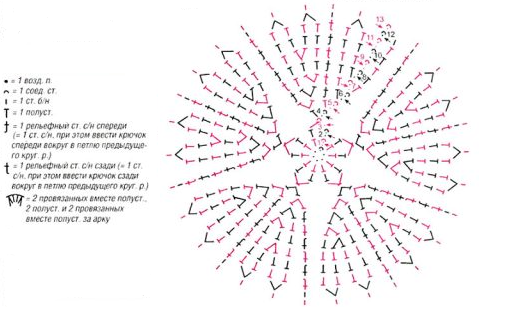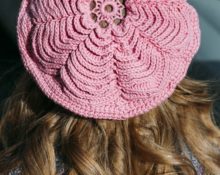Many lovers of needlework knit. But the hook is undeservedly on the sidelines. Some people mistakenly believe that crocheting patterns is much more difficult than knitting. But to dispel this myth and learn how to knit a gorgeous, fashionable winter beret in one evening, you should read this article.
Features of crocheting a winter headdress
 In order to knit a warm, beautiful winter pattern, you need to choose the right yarn. To keep the item warm, you should give preference to a thread that contains fibers:
In order to knit a warm, beautiful winter pattern, you need to choose the right yarn. To keep the item warm, you should give preference to a thread that contains fibers:
- sheep wool;
- camel hair;
- yak wool;
- alpaca;
- mohair.
Important! If the yarn contains alpaca or mohair, the final product will have a certain fluffiness.
Further you need to pay attention to the thickness of the yarn. The thicker the thread, the faster the beret or any other beautiful product will be knitted. But from such yarn it will be visually coarser. Although this season, it is precisely this technique of knitting from thick threads that is at the peak of popularity.
The next factor to pay attention to is thread color. You need to choose not only the tone you like, but also take into account how it will combine with outerwear and skin color.
After the yarn is selected, under it you should pick up a hook. Moreover, you should buy 2, or better yet 3 hooks at once. Especially if you have no experience in crocheting. So, for the elastic, you should take a hook of a smaller number, this will make this part more dense.
How to choose a pattern and knitting method?
As for the pattern, it all depends on taste. The only thing worth paying attention to is how “holey” the openwork will be.
Important! If the crochet pattern provides for too large holes between adjacent threads, then in winter such a product may not be entirely comfortable in terms of warmth.
It will be better if adjacent posts fit tightly to each other, and besides, such a model will be easy to knit for novice needlewomen.
Crochet a simple winter beret
For those who are just beginning their acquaintance with crochet, you can recommend a beret model knitted from thick threads with simple single crochets. In addition to the fact that such a headdress will be warm, it can be completed in just one evening.
Scheme and step-by-step description of work
So, for knitting you will need yarn of any color made from 100% wool, preferably sheep. You will need 3 skeins with a total weight of 150 grams. In 50 gr. the skein should have about 40 m of thread. For this thickness of yarn, hook No. 12 is suitable. In addition, it is worth buying hooks No. 11 and 13.
Sequence of work:
Before you start knitting the product, you should knit a 10 by 10 cm sample with simple single crochets.In this case, you should end up with a rectangle of 8 columns and 5 rows. If the knitting density corresponds to the presented sample, then you can knit the beret according to the pattern without deviations and additional calculations. The beret pattern fits a head with a girth of 50 to 54 cm.

Next, we begin knitting the product, which starts from the central part. To do this, you need to crochet a chain of 6 air loops and start knitting in a circle in accordance with the presented pattern. The diagram shows 12 rows - this should be enough to complete the beret from the central part to the circumference around the rim of the head. The symbol in the diagram is single crochets, half-columns and connecting columns.
After all 12 rows of the beret are knitted, it is necessary to close the edge of the product. To do this, a “crawly step” is performed. It’s easy to do - these are the same single crochets, but only knitted in the direction not from right to left, but from left to right.
If you wish, you can sew a pompom separately to the hat and decorate the central part of the beret with it. For the pompom, 6 chain stitches are knitted and closed into a ring. Next, it is knitted in circular rows in accordance with the presented pattern. But only from the first to the third row. After the third row the pompom is finished. To do this, you need to stuff the inside with the remnants of yarn and carefully pull it with threads to one point. Next, the tampon is sewn to the beret.
How to crochet an openwork beret for the winter?
For more experienced knitters, we can recommend an openwork beret model.
There is a large selection of different options here. Openwork patterns can be knitted in circular openwork rows.But there are also beret models that are knitted from separate openwork fragments and then assembled together into one whole product, but, as a rule, such models are knitted from thinner threads.
The beret knitted with the Solomon's Knots pattern looks very impressive. This openwork does not require much experience and looks very attractive. Moreover, for such a model we can recommend both plain smooth threads and a version of boucle or melange yarn.
Technology with diagram and description
For this beret you will need 130-140 grams. medium thickness yarn and hook number 4 or 5.
This product consists of two components. A strap that will wrap around your head and form a kind of elastic band. And the directly round part of the beret itself.
First the strap is knitted. For it you need to cast on 5 air loops and one lifting loop and then knit according to the basic plank pattern. Knitting will be approximately 3-4 rows. While knitting, after reaching the required length of the product, constantly apply the bar to the head to make sure that it corresponds to the individual size.

After the bar has reached the required parameters, it must be sewn into a ring.
Next, the upper part of the beret is knitted. To do this, you need to insert a hook into one of the side double crochets of the bar and tie one chain stitch and one single crochet into the same loop. Then a “Solomon’s knot” is knitted twice. This corresponds to what is shown in the diagram (it is necessary to tie and fasten two elongated loops in series). Then the next row of double crochets and one single crochet is skipped and repeated again from the beginning. And so it continues according to the pattern corresponding to the upper part of the beret.

The peculiarity of this beret is that it is knitted from the placket to the central part. Therefore, it is necessary to make a decrease in accordance with how indicated in the diagram. As a result, the knitting will converge to one point in the central part of the beret, where all the remaining loops are gathered together.


 1
1





